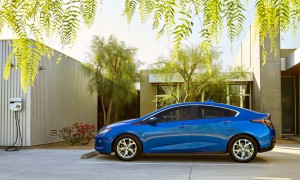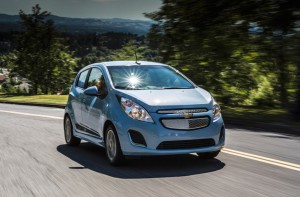
The 2016 Volt will get 50 miles per charge, which is an increase over the previous generation Volt. Volt sales are down 46.1% this year.
General Motors recently cut the price and increased the range on its Chevy Volt hoping to stimulate sales. It slashed the price on the Chevy Spark EV as well.
Ideally it wants to sell the vehicles to add to the company’s bottom line, but the Detroit-based automaker is also way off track to meet its very public goal of having 500,000 vehicles on the road that use electricity in some form for propulsion by 2017.
Through April, sales of the Volt are down 46.1% as well as for the Spark, which is purely an EV, which are down 4.2%.
Despite these efforts, it seems unlikely GM’s going to hit the mark as there were 180,834 GM vehicles on the road in 2014 in the U.S. with some form of electrification. That was up from 153,034 in 2013.

Chevy slashed the price on the Spark EV hoping to spur sales, which are only down 4.2% through April.
“For our commitment to electrification, our forecasted outlook currently projects us, along with the broader automotive industry, falling short of expectations for 2017,” the company said in its 2014 Sustainability Report.
“GM is committed to electrification and our award-winning eAssist, extended-range electric vehicle and battery electric vehicle offerings, but consumer demand for these vehicles has not kept up with our initial projections.”
Before castigating GM for not reaching its target, it should be noted the automaker has plenty of company in setting the EV bar too high. In his State of the Union speech in 2011, President Obama called for 1 million electric plug-in cars to be on American roads by 2015.
By 2013, Obama and the Energy Department conceded defeat on that battle. They’ll fail despite a slew of federal policies promoting EV adoption. The programs, which will cost $7.9 billion and run through 2019, include a $7,500 tax credit to purchase an electric vehicle.
For GM’s part, it’s still being proactive by lowering prices and introducing a slew of new hybrids across its line-up in the next two years. The new Chevy Bolt is expected to offer another low-cost, high-range option as well by 2017.
(GM cuts price, extends range of 2016 Chevrolet Volt. For more, Click Here.)
The reasons for consumers not gravitating to EVs are well documents, including range anxiety and higher costs, there’s a bigger short-term obstacle in the way of reaching the goal of 500,000: low gas prices.
Though gas prices have been on the rise in the last three weeks, they are still down more than $1 a gallon compared to this time last year. As a result, buyers who may have considered hybrids or battery-electrics are heading back to larger trucks, sport-utes and crossovers.
Sales of electric vehicles have been slumping throughout 2015, although the picture isn’t as clear as one might expect. Overall, hybrids and EVs are down 15.2%, according to the Electric Drive Transportation Association, but it’s the hybrids that are the sales anchor.
The association reports that 117,699 hybrids were sold in the U.S. through April compared with 140,866 through the first four months of 2014. Pure EV sales are up slightly: 31,352 units versus 31,027 for the year-ago period.
(Click Here for details about the demographics of EV buyers.)
Some makers aren’t all in on EVs as the future replacement for the internal combustion engine. Toyota, which has the most successful hybrid ever in the Prius, begins taking orders on its Mirai hydrogen fuel-cell vehicle this summer with deliveries starting this fall. Hyundai rolled out its Tucson hydrogen model last year and Honda’s FCV Clarity has been kicking around for several years.
However, GM is committed EVs, including finding ways to spur interest in the vehicles.
“The company believes the future is electric, with billions of investment to support an all-in-house approach to the development and manufacturing of electrified vehicles,” it said in a release.
(Chevy slashes price of pure battery-electric Spark EV. Click Here for more.)
Chevrolet is helping make EVs more mainstream by:
- Expanding sales of the Spark EV to Maryland, which has a strong infrastructure
- Committing to produce an electric family vehicle for all 50 states that will go 200 miles on a charge and cost roughly $30,000
- Designing the second-generation Volt arriving at dealerships this fall with a lower price than the original
- Announcing a hybrid version of the Malibu that is expected to get a combined 47 city/highway MPG
Additionally, Cadillac announced plans for a plug-in hybrid of its range-topping Cadillac CT6 and Buick offers e-Assist light electrification technology on its LaCrosse and Regal.

Even with tax payers improperly subsidizing EVs, most consumers do not want these vehicles. The only reason auto makers are trying to sell them is because Obama and the EPA have a gun against the heads of the auto makers, forcing them to try and sell products that consumers do not want. This is a perfect example of government gone bad and it’s disgraceful.